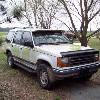N_tater
Member
- Joined
- March 21, 2017
- Messages
- 11
- Reaction score
- 0
- Year, Model & Trim Level
- 2000 explorer 4wd xlt
I drive a 2000 explorer. The fan completely stopped working. No matter what number I'm on and nothing for heat or AC. I checked fuses and they were good. I'm pretty sure its the blower motor but the videos ive seen show them changing either a blower motor under the hood or one under the glove box. How do I know which one it is? When I lofor the motor online I can only find ones labeled "front". Is it the same motor for either spot? Anything helps. Thanks in advance everybody.










